What Is the Meaning of the Egyptian Eye Symbol?
The Egyptian Eye Symbol, encompassing both the Eye of Horus and the Eye of Ra, is deeply embedded in ancient Egyptian mythology and iconography. It symbolizes divine protection, healing, restoration, and royal power.
The Eye of Horus, embodying protection and wholeness, reflects a mythological narrative of damage and restoration, while the Eye of Ra signifies the sun's regenerative power and divine watchfulness. Commonly depicted in ancient art, these symbols served as protective amulets and were integral to funerary practices.
Crafted from materials like gold and faience, they continue to influence modern art, fashion, and spiritual practices, hinting at further intriguing connections.
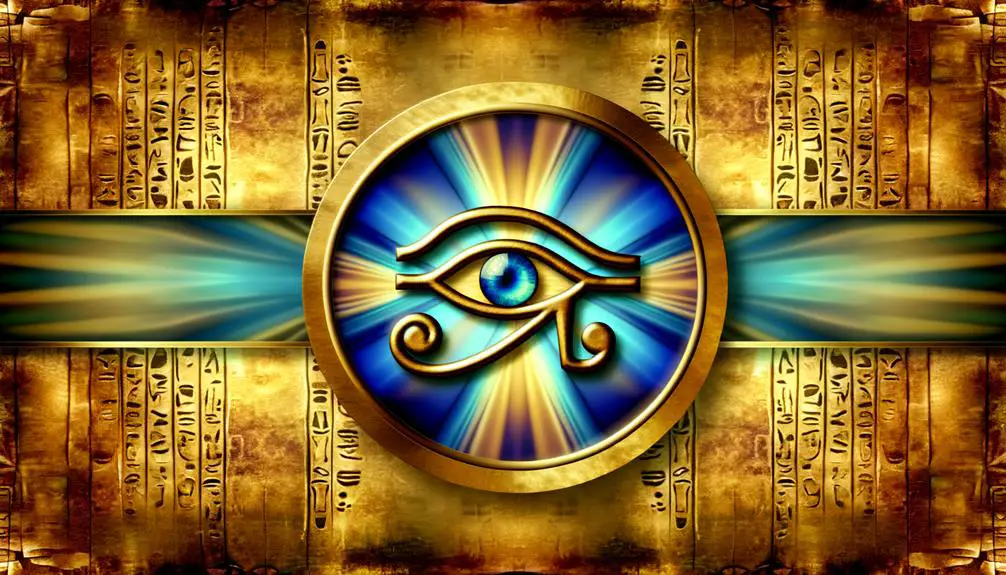
Key Takeaways
- The Egyptian Eye symbol represents protection, healing, and restoration.
- It is associated with the gods Horus and Ra, symbolizing divine power and safeguarding.
- In ancient Egypt, it served as a protective amulet against evil and malevolent forces.
- The symbol was widely used in art, tombs, and daily life for its spiritual significance.
- Modern interpretations connect the Eye symbol with inner vision, enlightenment, and heritage.
Origins of the Eye Symbol

The origins of the Egyptian eye symbol, often referred to as the 'Eye of Horus' or 'Wedjat,' can be traced back to ancient Egyptian mythology and religious practices, where it was imbued with profound symbolic significance.
This emblem is deeply rooted in the iconography of ancient Egypt, serving as both a protective amulet and a representation of divine power. It is associated with healing, restoration, and wholeness, reflecting the Egyptians' complex belief systems and their emphasis on the interconnectedness of health and spiritual wellbeing.
The symbol's intricate design, often depicted in tombs and artifacts, underscores its importance in rituals and daily life, highlighting the Egyptians' reverence for balance and harmony in the cosmos.
Mythology of Horus and Ra
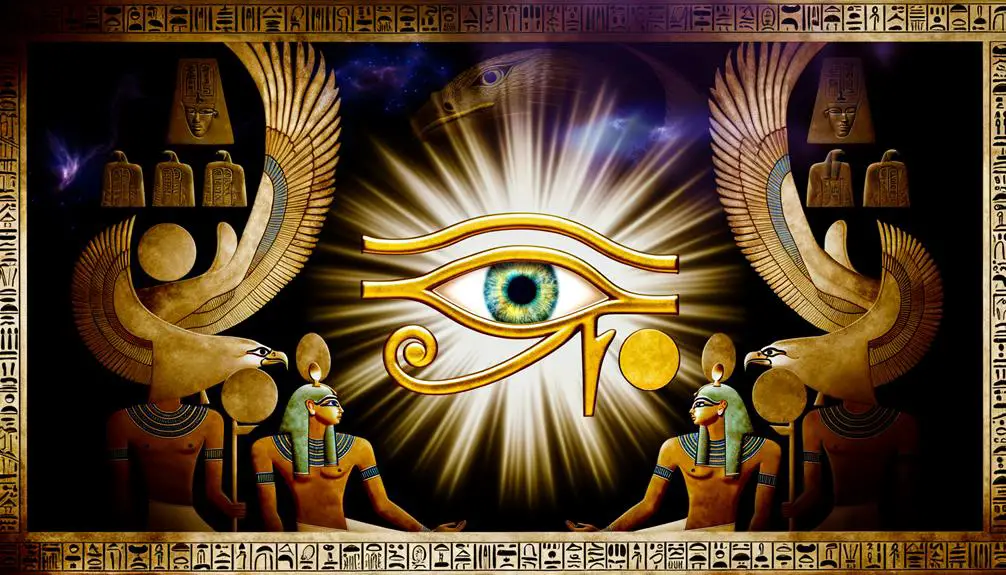
The mythology of Horus and Ra is central to understanding the Egyptian Eye symbol. Horus' eye, often referred to as the Eye of Horus, embodies protection, royal power, and good health. Ra's divine powers are manifested through the Eye of Ra, representing the sun's destructive and protective forces.
The mythological battle between Horus and Set, in which Horus' eye was injured and subsequently restored, further enriches the symbolic significance of these ancient icons.
Horus' Eye Symbolism
In ancient Egyptian mythology, the Eye of Horus, also known as the Wadjet, symbolizes protection, royal power, and good health, stemming from the epic conflict between Horus and his uncle Set. The myth narrates Set's violent act of gouging out Horus' eye during their struggle for the throne.
Thoth, the god of wisdom, later restored the eye, imbuing it with magical properties. Consequently, the Eye of Horus came to represent the restoration of order, healing, and wholeness. This symbol was widely employed in amulets to safeguard against malevolent forces and to guarantee the wearer's well-being.
Its intricate design, reflecting the fractional parts of the eye, also conveys a deeper understanding of the ancient Egyptians' mathematical prowess and spiritual beliefs.
Ra's Divine Powers
Building upon the significance of the Eye of Horus, the mythology surrounding Ra, the sun god, further illuminates the interconnectedness of divine powers in ancient Egyptian cosmology. Ra, often depicted with a solar disk, epitomizes the life-giving force of the sun. As the ruler of the skies, Ra's divine influence extended to maintaining cosmic order, known as Ma'at.
His daily journey across the sky symbolized the cycle of life, death, and rebirth, reinforcing his role as a creator and sustainer. Additionally, Ra's connection to the Eye of Ra, another powerful ocular symbol, underscores his protective and destructive capacities, embodying both nurturing light and formidable wrath. This duality enriches our understanding of divine symbology in Egyptian mythology.
Mythological Battle Story
Frequently interwoven within ancient Egyptian narratives, the mythological battles between Horus and Ra serve as profound allegories illustrating the dynamic interplay of order and chaos in the cosmos.
Central to these myths is the Eye of Horus, a symbol of protection, royal power, and health. The narrative recounts how Horus, the falcon-headed god of the sky, contended with Ra, the sun god, for dominance.
During these cosmic battles, the Eye of Horus was damaged, later restored by Thoth, the god of wisdom. This restoration symbolizes healing and the reestablishment of ma'at (cosmic order).
Through these mythic encounters, the Egyptians articulated their understanding of the perpetual struggle to maintain balance between opposing forces in the universe.
Symbolic Meanings
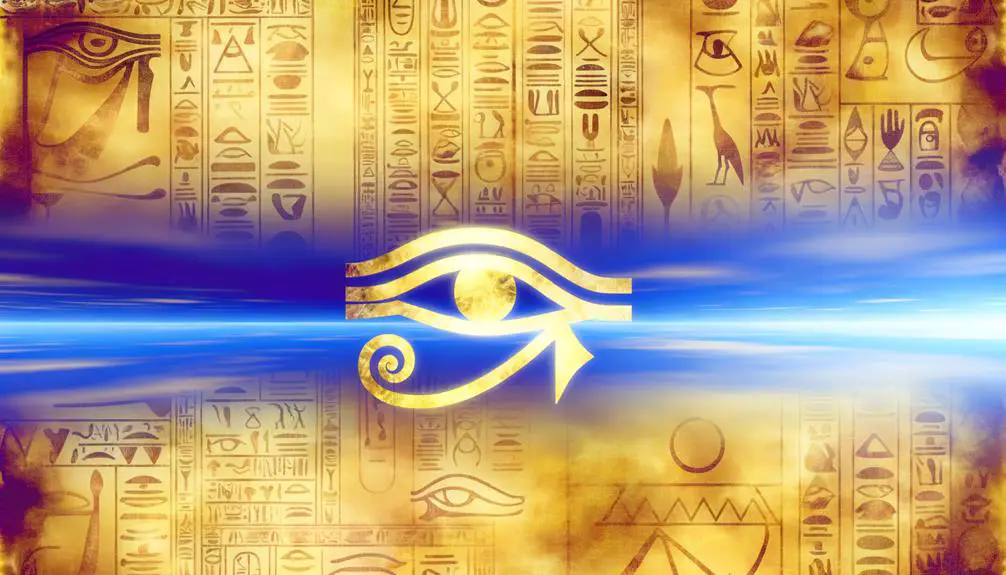
The Egyptian Eye symbol, often referred to as the Eye of Horus or the Eye of Ra, carries profound symbolic meanings rooted in protection, healing, and restoration. Ancient Egyptians believed that this emblem provided a divine safeguard against malevolent forces, while also promoting physical and spiritual well-being.
Symbolically, it embodies notions that extend beyond mere visual representation, reflecting complex theological and metaphysical principles.
- Protection: It served as an amulet to ward off evil spirits and negative influences.
- Healing: The symbol was associated with medical practices and believed to possess restorative powers.
- Wholeness: Representing the process of regeneration and completeness, often linked to lunar cycles.
- Sovereignty: It signified royal authority and divine power, underscoring the divine right to rule.
These facets illustrate the multifaceted significance of the Egyptian Eye symbol.
Use in Ancient Art

In ancient Egyptian art, the Eye symbol was ubiquitously depicted in various mediums, such as hieroglyphs, sculptures, and amulets, serving not only as a powerful emblem of protection and healing but also as a validation of its integral role in the visual and religious culture of the time.
Often represented as the Eye of Horus or the Eye of Ra, this symbol was meticulously crafted in tomb paintings and temple reliefs, embodying divine watchfulness. Artisans used detailed techniques to enhance its aesthetic and symbolic efficacy, embedding it in royal regalia and funerary artifacts.
This pervasive utilization underscores its importance in communicating religious narratives and ensuring the favor of the gods in both life and the afterlife.
Protective Properties
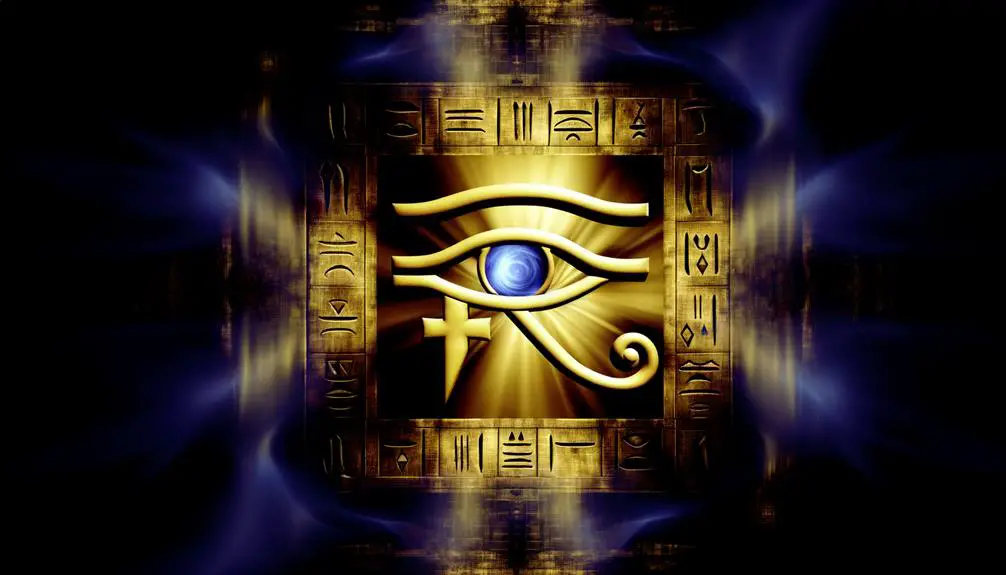
The Egyptian Eye symbol, particularly the Eye of Horus and the Eye of Ra, has long been revered for its protective properties. It was believed to ward off evil, acting as a potent amulet against malevolent forces.
Additionally, it served as a divine protection symbol, offering spiritual safeguarding power to those who bore its likeness.
Ward Off Evil
Renowned for its protective properties, the Egyptian Eye symbol, particularly the Eye of Horus, has historically been utilized as a powerful amulet to ward off evil and malevolent forces. This symbol, deeply rooted in ancient Egyptian mythology, was believed to possess potent defensive abilities.
Individuals would often carry or wear representations of the Eye of Horus, trusting it to shield them from harm and negative energies. Its use extends beyond personal protection, influencing various aspects of life and well-being.
- Personal Amulets: Small talismans worn to guard against misfortune.
- Architectural Inscriptions: Carvings on buildings to safeguard inhabitants.
- Funerary Practices: Placed in tombs to secure safe passage to the afterlife.
- Ritual Objects: Incorporated into religious artifacts to invoke divine protection.
Divine Protection Symbol
Beyond merely fending off evil, the Egyptian Eye symbol, especially the Eye of Horus, is intrinsically linked to divine protection, embodying the safeguarding power of the gods.
This revered symbol represents the vigilant watch of deities, ensuring the well-being of both individuals and the broader cosmos.
In ancient Egyptian belief, the Eye of Horus was seen as a powerful amulet, believed to bestow health, safety, and rejuvenation upon its bearer.
It was commonly used in funerary rituals to protect the deceased on their journey to the afterlife.
The symbol's protective properties were not limited to the physical domain; it was also believed to guard against spiritual perils, thus reinforcing its status as a potent emblem of divine guardianship.
Spiritual Safeguarding Power
In ancient Egyptian culture, the Eye of Horus was revered as a potent emblem imbued with spiritual safeguarding power, believed to protect both the physical and ethereal aspects of existence. This symbol, often depicted as a stylized human eye with distinctive markings, served multifaceted protective purposes. It was frequently used in amulets to ward off malevolent forces and guarantee safe passage in the afterlife.
Additionally, the Eye of Horus was employed in various rituals to invoke divine protection. Such uses underscore the emblem's integral role in ensuring comprehensive protection.
- Amulets: Shielding individuals from harm and evil spirits.
- Rituals: Invoking blessings and divine safeguarding.
- Burial Practices: Ensuring safe passage and protection in the afterlife.
- Architectural Elements: Guarding sacred spaces and structures.
Eye Symbol in Amulets
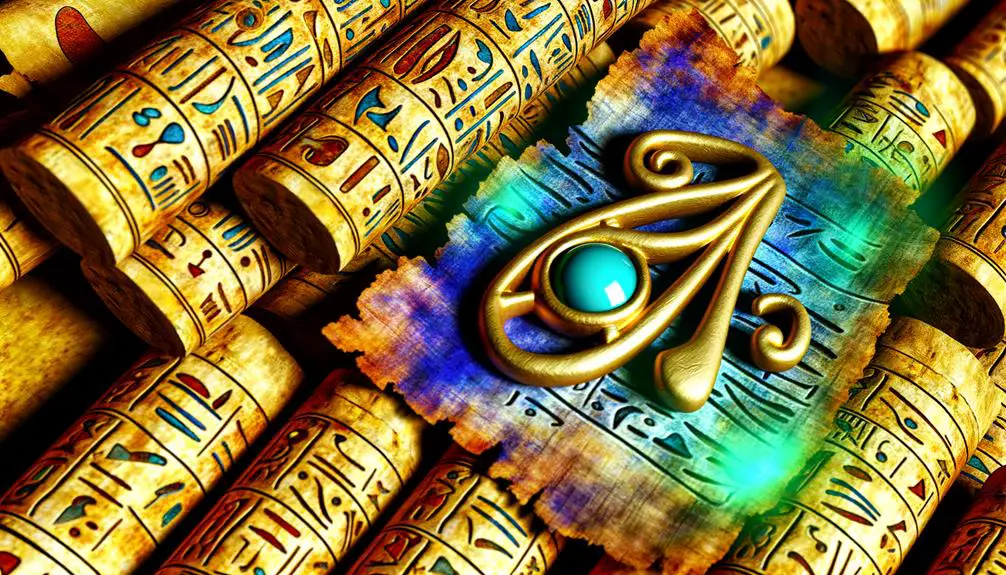
Amulets bearing the Egyptian eye symbol, often identified as the Eye of Horus or the Eye of Ra, served not only as protective talismans but also as symbols of healing and restoration in ancient Egyptian culture.
These amulets, crafted from materials such as gold, faience, and lapis lazuli, were believed to bestow the wearer with divine protection against malevolent forces and illnesses.
The Eye of Horus, imbued with mythological significance, represented the restoration of order and health after Horus' eye was healed by Thoth. Similarly, the Eye of Ra symbolized the sun's regenerative power.
Amulets featuring these symbols were commonly placed within tombs and worn by the living, underscoring their significance in both life and death.
Modern Interpretations
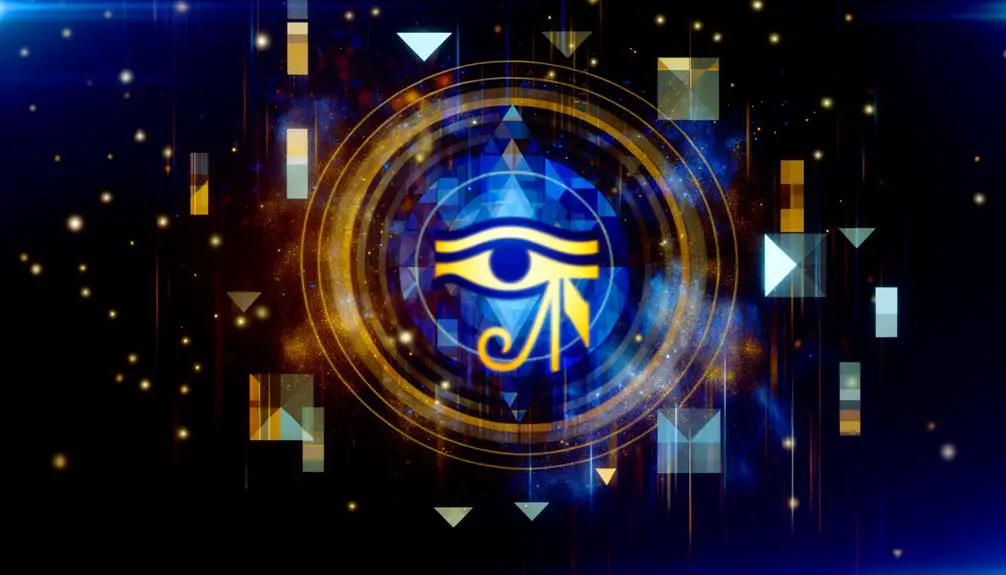
While the ancient Egyptian eye symbol historically functioned as a potent emblem of protection and restoration, its modern interpretations encompass a diverse array of cultural, spiritual, and aesthetic significances.
Today, the symbol is often seen as a versatile motif in various contexts, reflecting its enduring resonance through time. The contemporary understanding of the eye symbol includes:
- Spirituality: It is frequently associated with inner vision and enlightenment, offering protection against negative energies.
- Cultural Identity: Many people use it to connect with their ancestral heritage and traditions.
- Art and Fashion: The symbol is a popular design element in jewelry, tattoos, and clothing, representing timeless beauty and mystique.
- New Age Beliefs: It is embraced within esoteric circles for its supposed metaphysical properties and healing capabilities.
Cultural Impact Today
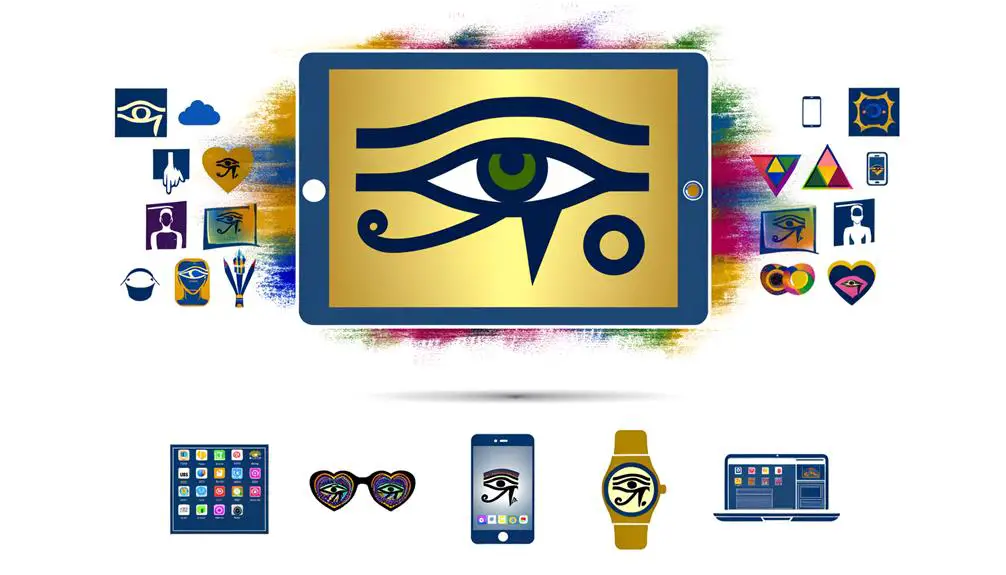
The pervasive influence of the ancient Egyptian eye symbol in contemporary society underscores its significant role as a multifaceted icon that transcends cultural and temporal boundaries.
Today, the symbol, often referred to as the Eye of Horus or the Eye of Ra, appears in various domains, including fashion, art, and popular culture. It is frequently employed as a design element in jewelry and tattoos, symbolizing protection, health, and restoration.
Moreover, its presence in modern esoteric practices and new-age spirituality highlights its enduring mystical allure. Academic interest also persists, with scholars exploring its semiotic implications and historical context.
The Egyptian eye symbol remains a potent emblem of ancient wisdom, continually reinterpreted in contemporary settings.
Conclusion
The Egyptian eye symbol, steeped in ancient mythology and rich in symbolic meaning, continues to captivate across millennia. Its origins, intertwined with the tales of Horus and Ra, bestow it with multifaceted significance, from protection to divine insight.
As it adorned art, amulets, and modern interpretations, the symbol's cultural impact deepened. Yet, one must ponder: what further mysteries does this enigmatic emblem hold, waiting to be discovered by future scholars and enthusiasts alike?





